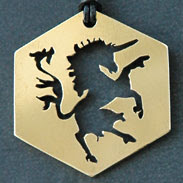Torch Forged Rings
Part 4 - Rounding, Filing/Sanding, & Finishing
made by Ash
Unicorn's Garden
When the rings come out of the pickle pot they are white. I'm told the white is pure silver on the surface but I don't know if that is true or not. It is just the way sterling silver is when it comes out of the acid solution.
 |
| Rings fresh out of the pickle pot |
The rings are now formed but there is still work to be done. First is to round the rings on a ring mandrel as the process of aligning the joint earlier never allows for a truly round ring. Also the rings are hammered with a rawhide mallet on the pounding block to take out any warping in the band. Once the ring is round and no longer warped, it is time to sand and file again. The outside and inside of the band get filed to remove excess solder then sanded for smoothness. Next comes the edges of the rings that I did nothing with while the ring band was still flat. First both edges get filed and checked with a caliper for consistent band width. Adjustments are made according to the caliper readout. Again this is not a machine precise process but I try to stay well below a 0.1 mm variance.
The flats of the edges are then sanded with the previously mentioned regiment of grits and the inside of the edge is filed to round it out a bit. Next comes final sizing. For this it is a repetitive process of putting the ring on the ring mandrel and hitting it with a rawhide mallet. Through using the mallet and flipping the ring over throughout this process the ring is stretched to the proper size. This process can involve using a steel hammer if the there is too big of a difference between the size the ring is and the size it needs to be. If a steel hammer is used the outside of the ring is again filed and sanded to take out any hammer marks.
Once the ring is the proper size the outside of the edge gets filed and both the outside and inside edges get sanded to remove file marks. This makes for a more comfortable fit as there isn't a square edge to press against fingers when worn. This part of the process is the same for forged and fabricated rings.
After all file marks and scratches have been removed from the outside, inside, and edges of the rings they are polished. For this I use a muslin wheel with polishing compound on a flex shaft. I don't have a spot to set up my polishing station with the big muslin wheel yet but that will come in time. After polishing the rings are put into an ultrasonic with a bath of cleaning solution followed by a water rinse. This removes the excess polishing compound from the rings. For plain bands the rinse and a final wipe down with a polishing cloth is the last step but not for the two forged rings pictured here.
 |
| Finished Torch Forged and Stamped Rings |
This concludes how the forged rings are made. Next week the mishaps that occurred ;)






Votre blog est bien fait et j'ai apprécié la lecture de ce post. eavestrough replacement Mississauga
ReplyDelete